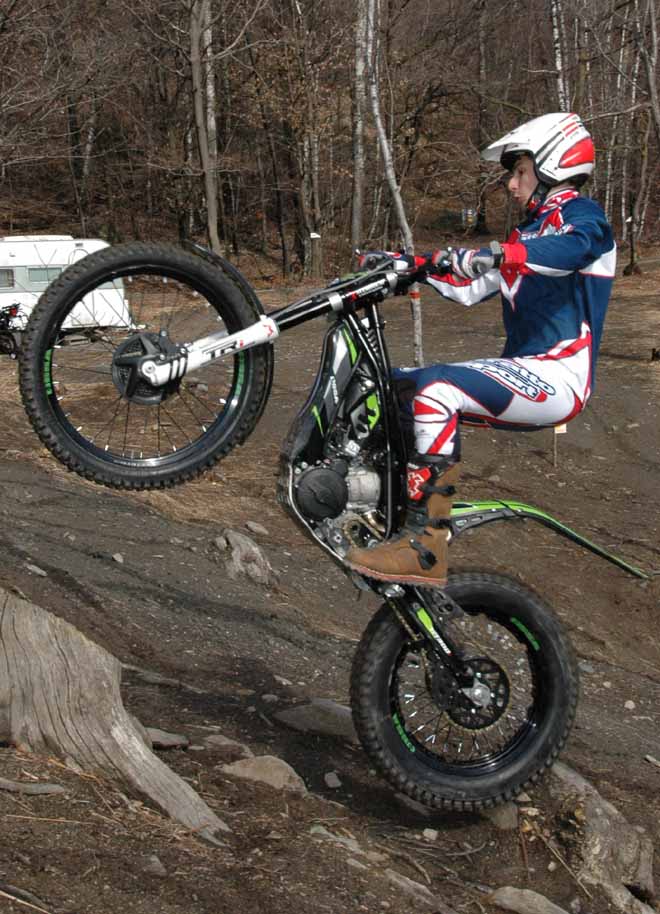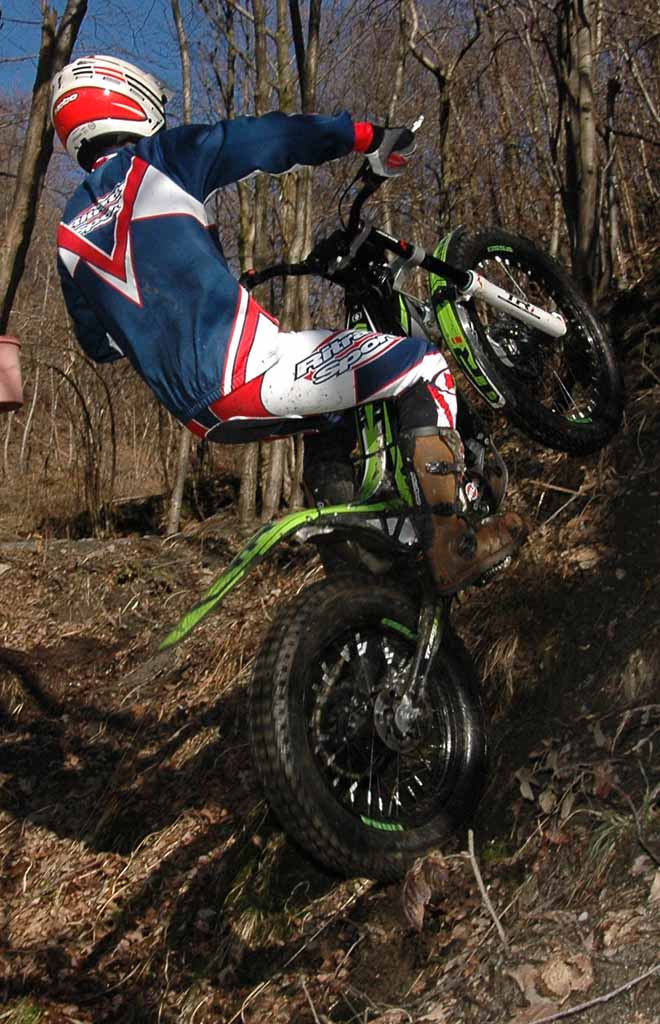01/03/15 - Ossa TRi 300
Founded in 1940, the Spanish factory of the four-leaved clover, that means the legendary Ossa, is celebrating the 75th anniversary of his birth. Made famous in the 70s for the Trial model developed and brought to the competitions by one of the greatest champions of that time and perhaps one of the most long-lived as a dedication to the trial, ‘cause nowadays he still works as an instructor, English Mick Andrews, the Company had then faced the first major Spanish crisis, brought even to go bankrupt at the end of the 80s. The brand was then taken up by some Spanish businessmen in 2009, and soon a motorcycle highly innovative was launched, the one that, although with several small changes, we went to test today.
Injection two-stroke engine, cylinder tilted provocatively in the other direction (but there is a reason) incredibly light weight. Other details such as upside-down forks found on the first series, were later abandoned for the classic’s that seem to give more reliability. The TRi of 2015 represents the fifth generation of these historic TR series, a compact and lightweight trial designed to meet the needs of all riders, from the professional to the amateur. Still injection two-stroke engine, liquid cooled, produced in 125, 250, 280 and 300 cc, 6-speed gearbox with a dry weight of 64.5 kilos. As suspensions, in front we have a hydraulic fork Marzocchi 40 mm, while the rear is a mono-shock absorber Öhlins TTX. The braking system relies on front a disc 185 mm diametr, mated to a 4 piston , and on rear 150 mm disc with 2-piston pin.
The test was carried out in a winter Sunday with temperatures between 8 and 13 degrees. We used the authorized area belonging to BM Racing, Trials dealer from Bricherasio, near Turin. About what the Testing Team consists of, please click here.
RIDING
What let’s immediately amazed us is to start the engine without having to enrich the gasoline, pulling the classic choke lever on the carburetor. This happens thanks to the direct injection. Electronics decides the air-fuel mixture more suitable according to the temperature . So the kick must be determined when it is cold. Started at the third try in our winter sun, then always at first’s with the engine warm. The sound reminds us of the first SWM with rotating disc , with that pleasant hissing sound that makes it unique in its category . The six-speed gearbox is well compared : as usual the first three gears are those used in the sections or in the most demanding passages in the mountaineering tours. No problem in shifting the speeds: always accurate.
The clutch denotes a different behavior depending on the temperature of the oil. Excellent for "moderate” users, it becomes difficult to manage in an exasperated use, because after a few hours of triasl at high level, the point of detachment changes and the pilot has to adapt his riding to the change, immediately. A behavior that the medium or low skill user can not feel, not only but from his point of view he appreciates a lot the gradual and softness of detachment, that prevents those jerks forced by those clutches "on-off" , typical of the most extreme trials-bikes.
Speeds "stretch" well and as you become familiar with the quite different noise, you are at ease in dealing with various obstacles. appreciating the direct injection. Indeed opening the gas, the torque output is always constant and progressive in any situation. Riding you have soon the feeling of its very light weight, distributed evenly on the front axle and on the rear axle. Despite having a huge "ground clearance", that allow you not to touch the sump shield in the narrow passages on the stones, the grip is always good, even on particularly slippery terrain or in pure mud.
A little too much down the rear brake pedal (but it is possible to adjust it) that forces in fast weight changes, like slope immediately after steep climb, to shift your weight on the right for making a decisive action on the pedal. Braking is still excellent. The steering angle is aligned with rivals and designed for professional use, however, even the amateur is not despised knowing that on steep downhill hardly the steering tends to "mow down". Soft suspensions in the bike being tested, but they can easily be calibrated for different needs, seeing as both fork and mono are adjustable.
In short, the Ossa TRi 300 is definitely a perfect all-rounder for a wide range of users. Remains the unknown reliability since some customers were disappointed by the first models, but talking to the importing company, the SRG motorcycles from Cantu, we were reassured that all the problems of the first generations were finally resolved and that the bike is more robust for long-term use.
------------------------------------------------------------------------------------------
Fondata nel 1940, la casa spagnola del quadrifoglio, ovvero la mitica Ossa, festeggia quest’anno il 75° anniversario della sua nascita. Resa famosa negli anni 70 per il modello Trial sviluppato e portato in gara da uno dei più grandi campioni dell’epoca e forse uno dei più longevi come dedica al Trial, visto che ancora oggi esercita come istruttore, l’inglese Mick Andrews, la Casa aveva dovuto fronteggiare la prima grande crisi dell’industria spagnola, finendo per chiudere i battenti a fine anni ’80. Il marchio è stato poi ripreso da appassionati imprenditori spagnoli nel 2009, sotto il quale è stata lanciata una moto altamente innovativa, quella che, sebbene con diverse piccole modifiche, siamo andati a provare oggi.
Motore a due tempi ad iniezione, cilindro inclinato provocatoriamente nell’altro verso (ma la ragione c’è) e peso incredibilmente contenuto. Altri particolari come le forcelle rovesciate le abbiamo trovate solo sulle prime serie, poi abbandonate per le classiche che sembrano dare più affidabilità. La TRi del 2015 rappresenta la quinta generazione della sua ormai storica serie TR, una trial compatta e leggera studiata per soddisfare le esigenze di tutti i piloti, dal professionista all’amatore. Solito propulsore 2 tempi a iniezione raffreddato a liquido e proposto nelle cilindrate 125, 250, 280 e 300 cc, cambio a 6 marce con un peso a secco di 64,5 chili. Come sospensioni, davanti abbiamo una forcella idraulica Marzocchi da 40 mm, mentre dietro c'è un mono-ammortizzatore Öhlins TTX. L'impianto frenante invece conta su un disco da 185 mm all'anteriore, accoppiato ad una pinza a 4 pistoncini, e un disco da 150 mm dietro con pinza a 2 pistoncini.
La prova e’ stata effettuata in una domenica d’inverno con temperature tra i 8 ed i 13 gradi. Abbiamo utilizzato l’area autorizzata della concessionaria BM Racing di Bricherasio. Su come e' formato il Testing Team vi chiediamo di cliccare qui.
IN MOTO
Ci colpisce subito all’avviamento non dover arricchire la benzina tirando la classica levetta dell’aria sul carburatore. Qui c’è l’iniezione diretta e l’elettronica decide la miscela aria-benzina più consona in base alla temperatura. Dunque il calcio deve essere ben deciso a freddo. Partenza al terzo colpo nella nostra domenica d’inverno, poi sempre al primo col motore caldo. Il rumore ci ricorda i primi SWM a disco rotante, con quel sibilo piacevole che la rende unica nella sua categoria. Il cambio a sei marce è ben rapportato: come al solito le prime tre marce sono quelle utilizzate nelle “zone controllate” o nei passaggi più tralistici per i cultori del motoalpinismo. Nessun problema nell’innesto: sempre preciso.
La frizione denota invece un comportamento differente a seconda della temperatura dell’olio. Ottima in un uso “moderato” per utenti medi, diventa difficile per usi esasperati, perché dopo qualche ora di trial a livello alto, cambia il punto di stacco ed il pilota deve sapere immediatamente adeguare la sua guida al cambiamento. Un comportamento che l’utente medio non riesce a notare, anzi dal suo punto di vista apprezza molto la gradualità e morbidezza dello stacco, che gli evitano quei sussulti che spesso e volentieri costringono le frizioni “on-off” dei mezzi più estremi.
Le marce “allungano” bene e appena presa confidenza con il rumore , come abbiamo detto differente, ci si trova a proprio agio nell’affrontare i vari ostacoli. Qui l’iniezione diretta si fa sentire: l’erogazione è costante e progressiva all’apertura del gas in qualunque situazione. Si avverte molto la leggerezza, distribuita equamente sia sull’avantreno che sul retrotreno, mentre pur avendo una grande “luce” da terra, che consente di non toccare la piastra motore nei passaggi stretti sulle pietre, l’aderenza è sempre buona, anche su terreni particolarmente viscidi o nel fango puro.
Un po’ troppo in basso la leva del freno dietro (ma si può rimediare regolandola) che costringe nei veloci cambiamenti di peso, tipo discesa immediatamente dopo ripida salita, ad uno spostamento eccessivo del peso sulla destra a seguito di una decisa azione sul pedale. La frenata comunque è ottima. L’angolo di sterzo è allineato alle concorrenti e studiato per un uso professionale, tuttavia non viene disprezzato dall’amatore nei tratti in discesa in cui difficilmente lo sterzo tende a “prendere sotto”. Sospensioni morbide nella moto in prova, ma che possono facilmente venire tarate per esigenze diverse, visto che sia la forcella, sia il mono sono regolabili.
Insomma l’Ossa TR i 300 e’ sicuramente una moto straordinariamente versatile per un’ampia gamma di utenti. Resta l’incognita affidabilità a causa di qualche cliente deluso dai primissimi modelli, ma dalla ditta importatrice, la SRG motorcycles di Cantù , ci hanno rassicurato che tutti i problemi delle prime generazioni sono stati definitivamente risolti e che la moto risulta più che robusta per un uso duraturo nel tempo.
Il prezzo a cui viene proposta e' 7240 euro.














------------------------------------------------------------------------------------------
------------------------------------------------------------------------------------------
| OSSA TRi 300 | |
| motore / engine | 2 tempi, iniezione diretta ,raffreddato liquido / 2-stroke , admission direct reed crankcase, liquid cooling |
| cilindrata / displacement | 294 |
| alesaggio x corsa / bore x stroke | 79 x 60 |
| accensione / ignition | Kokusan CDI digital magnetic flywheel |
| alimentazione / fuel supply | iniezione elettronica Kokusan Batery-less/ EFI Kokusan Batery-less System |
| lubrificazione / lubrification | miscela 0,8%/mix oil/gasoline 0,8% |
| frizione / clutch | comando idraulico/hydraulic control |
| trasmissione / trasmission | 6 marce/speed |
| telaio / frame | tubolare in acciaio al Cromo Molibdeno con tubo di alluminio e alluminio forgiato nella parte inferiore/tubular profile CR-Mo steel with pipe and forged aluminum lower |
| forcelle / forks | idralulica MARZOCCHI 40 mm, ritorno regolabile in smorzamento e compressione / adjustable compression and rebound |
| mono / monoshock | Ohlins TTX regolabile nel precarico molla e nel freno idraulico in estensione e compressione / adjustable compression and rebound |
| cerchi / rims | MORAD |
| gomma anter. / front tyre | MICHELIN comp. 2,75 x 21 |
| gomma post. / rear tyre | MICHELIN X11 4,00 x 18 |
| freno anter. / front brake | BRAKTEC disc 185 mm |
| freno poster. / rear brake | BRAKTEC disc 150 mm |
| serbatoio / tank | litri 2,6 |
| peso a secco / dry weight | 64,5 kg |
| interasse / wheelbase | 1328 mm |
| altezza sella / seat height | 655 mm |
| luce da terra / ground clearance | 340 mm |

